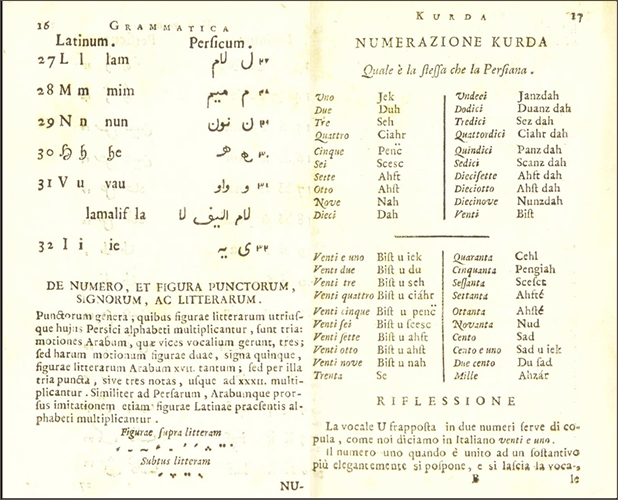
Kurdish is an Indo-European language spoken by approximately 30 million people in the Kurdistan region, and many others in diaspora.[1] Kurdistan spans eastern Turkey, northern Iraq, and western Iran and smaller parts of northern Syria and Armenia.[2] In 1992, Kurds in northern Iraq established the autonomous government, Kurdistan Regional Government, while Kurds in Iran are still seeking official recognition especially in the inhabited Iranian province of Kordestan.[3]
According to Philip Kreyenbroek in the Encyclopedia of Language and Linguistics (2006), “Kurdish is spoken in three main variants: Northern Kurdish, comprising Kurmānjī in the west and dialects spoken from Armenia to Kazakhstan; Central Kurdish, spoken in northeastern Iraq (called Sōrāni) and adjacent areas in Iran (called Kordi or Mokri), as well as in Iranian Kurdistan (called Senne’i); and Southern Kurdish, spoken in Kermanshah province in western Iran (including Lakki and Lori of Posht-e Kuh).”[4] The two widely spoken dialects of Kurdish language are Sōrāni and Kurmānjī; where Sōrāni dialect is written in Perso-Arabic script, the Kurmānjī dialect is written in Latin script.[5]
For most its history, Kurdish was not used as a written language. Those who aspired to contribute to the elevated, written culture of their times wrote in Arabic, Persian or, later, Turkish.[6] Sharāfnama, or The History of Kurdish Nation, a famous book about the history of the Kurds in the medieval period, was written originally in Persian in 1597, and later translated into many languages including Turkish, French, German, Russian, Arabic, Kurdish and English. The first Kurdish translation of Sharāfnama was carried out in Russia in 1858, published in Moscow as a book entitled Tawārīh-i ḳadīm-i Kūrdistān by Mahmud Bayazidi in 1986, in Kurmānjī dialect. A new translation in Sōrāni dialect entitled Sharafnāmah-yi Sharafkhānî Bidlīsī by Hejar was published in Iraq in 1972.[7]
Grammatica e vocabolario della lingua Kurda, which was published in 1787 by Maurizio Garzoni as the first grammar and vocabulary book, was used for a long time among scholars as the standard reference tool for the Kurdish language.[8] More recently in the West, the doctoral thesis of David Neil Mackenzie, which was later published as a book in two volumes entitled Kurdish Dialect Studies is considered a groundbreaking study, especially for Kurdish dialects of Iraq.[9]
Kreyenbroek writes: “Kurdish poetry and prose narratives were transmitted orally. However, the form, language and imagery of the earliest known Kurdish written poetry effortlessly follows the models offered by Arabo-Persian poetry, which suggests that the tradition had been perfected before the known early poets appeared.”[10] One of the examples of popular classical Kurdish poets was Ahmad Khani (1650-1707). He wrote what is considered, the most famous romantic epic Mamu Zayn, which is likened to Shakespeare’s “Romeo and Juliet.” It has been translated and reproduced widely in different languages, works and films.[11]
Recent histories of literary Kurdish literature varies based on different national accounts of the lands of Kurdish speaking people. In 1991 the Turkish government recognized the existence of the Kurdish language, which led to the publication of more literary works in Turkey. In Iraq, the first printing press of Kurdistan was established in Sulaymaniyah in 1919. The printing press helped in establishing various Kurdish newspapers and the production of literary works especially in Sōrāni. In Iran, at least two of the Kurdish poets were recognized nationwide as the “national poet of the Republic of Kurdistan.” These are Abd al-Raḥmān Sharafkandī (Hazhar or Hejar), and Hemin Mokriani. In Armenia, there is a small but active community especially in producing poetry and prose.[12]
At Berkeley, in the Near Eastern Studies Department, with funding support from the Center for the Middle Eastern Studies, Kurdish language and culture classes have been offered sporadically in the last decade. In addition to language classes, Kurdish is included in such courses as the “Sociolinguistics of the Greater Middle East” class, which was offered in 2019 and 2020.[13] In the Library, scholarly works for the study of Kurdish are one of the Library’s distinct strengths for the region.
Contribution by Mohamed Hamed
Middle Eastern & Near Eastern Studies Librarian, Doe Library
Sources consulted:
- Encyclopædia Britannica, https://www.britannica.com/topic/Kurdish-language (accessed 8/3/20)
- Encyclopædia Britannica, https://www.britannica.com/topic/Kurdistan (accessed 8/3/20)
- The Kurdish Project, https://thekurdishproject.org/kurdistan-map (accessed 8/3/20)
- Encyclopedia of Languages & Linguistics / Keith Brown, editor-in-chief; co-ordinating editors, Anne H. Anderson … [et al.]. 2nd ed. (Boston: Elsevier, c2006), 265-266.
- Kurdistan Regional Government, http://cabinet.gov.krd/p/page.aspx?l=12&s=050000&r=305&p=215 (accessed 8/3/20)
- Encyclopædia Iranica, http://www.iranicaonline.org/articles/kurdish-written-literature (accessed 8/3/20)
- Anwar Soltani, “The Sharafnama of Bitlisi: Manuscript Copies, Translations and Appendixes” in Kurdistanica.com, http://kurdistanica.com/the-sharafnama-of-bitlisi-manuscript-copies-translations-and-appendixes (accessed 8/3/20)
- Encyclopedia of Languages & Linguistics / Keith Brown, editor-in-chief; co-ordinating editors, Anne H. Anderson … [et al.]. 2nd ed. (Boston: Elsevier, c2006), 265-266.
- Encyclopædia Iranica, http://www.iranicaonline.org/articles/mackenzie-david-neil-1 (accessed 8/3/20)
- Encyclopædia Iranica, http://www.iranicaonline.org/articles/kurdish-written-literature (accessed 8/3/20)
- Encyclopædia Iranica, http://www.iranicaonline.org/articles/meme-alan (accessed 8/3/20)
- Encyclopædia Iranica, http://www.iranicaonline.org/articles/kurdish-written-literature (accessed 8/3/20)
- Kurdish – Berkeley Academic Guide (accessed 8/3/20)
~~~~~~~~~~
Title: Grammatica e vocabolario della lingua Kurda
Title in English: Grammar and vocabulary of the Kurdish language
Author: Garzoni, Maurizio, 1730-1790.
Imprint: Rome, 1787.
Edition: 1st
Language: Kurdish
Language Family: Indo-European, Indo-Iranian
Source: The Internet Archive (Wellcome Library)
URL: https://archive.org/details/b28777086/page/n3/mode/2up
The Languages of Berkeley is a dynamic online sequential exhibition celebrating the diversity of languages that have advanced research, teaching and learning at the University of California, Berkeley. It is made possible with support from the UC Berkeley Library and is co-sponsored by the Berkeley Language Center (BLC).
Follow The Languages of Berkeley!
Subscribe by email
Contact/Feedback
ucblib.link/languages
![The Languages of Berkeley [fan]](https://update.lib.berkeley.edu/wp-content/uploads/2019/02/fan_languages-450px.jpg)